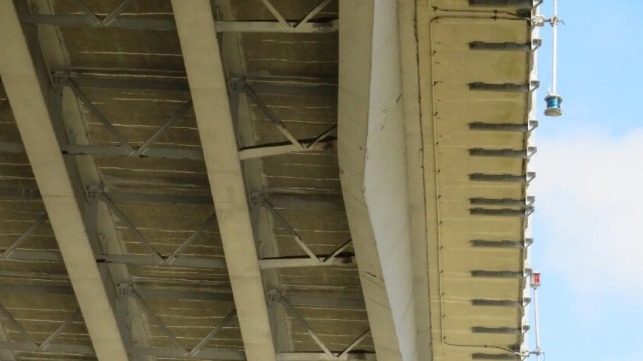NTSB: Master's Mistaken Air Draft Estimate Caused Bridge Strike

The National Transportation Safety Board (NTSB) has concluded its investigation into the allision of a crane barge with a highway bridge at Houma, Louisiana last year, and it has determined that the operating company didn't do enough to verify the height of the crane boom before making the passage.
On March 5, 2022, Sealevel Construction chartered the towboat Robert Cenac to tow the crane barge Mr. Dawg and a deck barge from Houma to Clovelly, Louisiana, along the Intracoastal Waterway. Operator Al Cenac Towing asked Sealevel at least twice about the height of the crane before departure, but Sealevel did not provide a verified crane height. The last construction crew on the barge had left the crane at an elevated angle, sticking up above the spuds.
Without a verified height to calculate air draft, the Robert Cenac's captain - a 23-year veteran of the towing industry - made an estimate. At about 2200 hours, in the dark of night, the master looked at the crane boom and estimated that the part that stuck up above the spuds was about 10 feet. Assuming that the spuds were 50 feet, the local standard, the master guessed that he had a total air draft of “roughly 60 feet.”
However, this was incorrect. The raised spuds on the Mr. Dawg had an air draft of about 56 feet, not 50 feet, and the crane boom tip stuck up at least as high as the maximum air draft of the Houma Twin Span Bridge - 72.8 feet.
At 2330 hours, the master let his dispatcher know that he was comfortable with the tow, and he got under way towards Clovelly. The mate took over the watch at 2340, and he told investigators that he could not see the head of the boom in the dark.
At 0038, the head of the crane boom struck a steel stringer on the underside of the Twin Span Bridge at about four knots. The stringer was bent inward by the impact, and the damage was significant enough to shut half the bridge until March 16.
The NTSB determined that the probable cause of the bridge strike was the tow captain’s incorrect estimate of the crane boom height and his decision to depart before getting a confirmed height from the crane barge owner. The barge owner's failure to provide a confirmed height was a contributing factor.

that matters most
Get the latest maritime news delivered to your inbox daily.
“Tow operators are required to know the air draft of their vessel and tows and should not make assumptions,” NTSB concluded. “As the NTSB has recommended before, tow operators should have a detailed voyage plan with specific information concerning/about all known risks, including calculated overhead clearance limitations for tows. In this case, the captain should have waited to get underway until the exact air draft of the tow was established.”
The captain told investigators that in his two decades on the southern inland waterways, he had never received a written air draft declaration for a tow.
